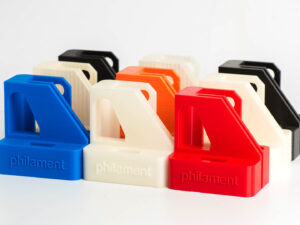High tensile strength
Showing all 3 results
-
 Details
DetailsFilaticum Engineering
22 290 Ft – 74 290 Ft 16 535 Ft + VAT Add to cartThis PLA-based filament offers enhanced possibilities for industrial applications. The thermal stability of objects printed with Filaticum Engineering is extremely high, they could bear up to 120 °C heat, in most of the cases without any heat treatment after printing.
Filaticum Engineering is also much more resistant to other external impacts than standard PLA materials: it has a high tensile and compressive strength and extremely high stiffness, making it an excellent material for objects that are exposed to typical influences in industrial environments.
-
 Details
DetailsFilaticum Glass Reinforced
18 990 Ft – 63 290 Ft 14 173 Ft + VAT Add to cartThe strength, hardness, and heat resistance of filament reinforced with glass fiber go far beyond the characteristics of the standard PLA. It can withstand heat of up to 100 0C. The biopolymer-based filament is also suitable for printing lightweight parts, even applicable for replacing metal parts. The printed surface is unique, glassy, so it is also a perfect choice for designers. The warping of objects printed with Filaticum Glass Reinforced is very low. Recommended printing parameters: 215 0C nozzle, 60 0C bed. If you are printing continuously in bigger quantities (above 1-2 kg), hard nozzles are recommended, in this case the printing parameters should be adjusted accordingly. Direct drive is recommended.
-
 Details
DetailsFilaticum Electrical: Antistatic
36 990 Ft – 123 290 Ft 27 559 Ft + VAT Add to cartFilaticum Electrical products are used mainly in the electronics and automotive industry where electrostatic charging of the printed object can damage the product. Objects printed with Filaticum CONDUCTIVE, ESD or ANTISTATIC do not charge electrostatically due to the special carbon and chemical additives. Additionally, the dust and fine powder does not stick on the surface.
To decide for which application which filament suits the best, can be determined mainly experimentally. It depends on the electrical and mechanical requirements of the objects, and the 3D printing parameters. Filaticum Antistatic has the best mechanical properties, similar to standard PLA. Filaticum Conductive is the most rigid in this line, because of the used carbon powder and fiber, required for conductivity. Filaticum ESD is somewhere in the middle range.
Filaticum Antistatic: its main feature is the immediate and permanent antistatic effect. Its important characteristic also that it does not absorb the moisture content of the air. It keeps most physical properties of PLA, and it has increased impact strength compared to PLA. It can be produced in any color. No sloughing, off gassing or blooming.
For proper printing results use PLA printing settings: we recommend 210-230 °C printing temperature, at least 0.2 mm nozzle, and printing speed no higher than 90 mm / sec. Bed temperature 40-60 °C, usually any type of surface can be used.
